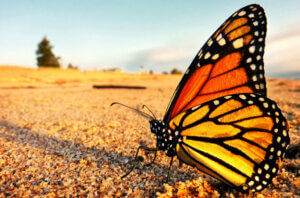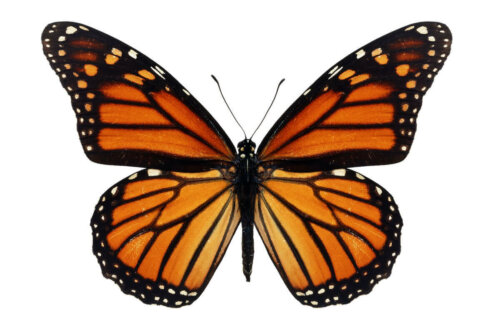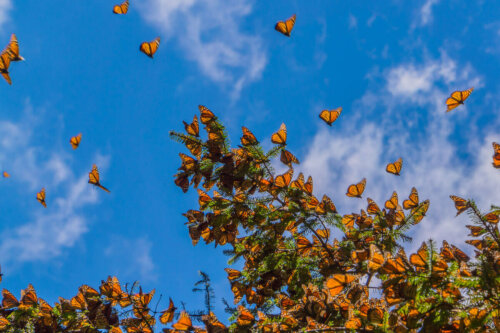The Amazing Monarch Butterfly Migration


Written and verified by biochemistry Luz Eduviges Thomas-Romero
The larvae of the monarch butterfly (Danaus plexippus) eat the shell of the egg they hatch from. All monarch larvae feed on the cotton plant they’re born on, but not all of them will undertake the mythical journey to warmer lands that they’re so well-known for.
An essential feature of monarch butterfly migration involves the exceptional longevity of the adult migrants. The “Methuselah” generation has great endurance and longevity of up to nine months, from August/September to March. In contrast, their summer-born counterparts are likely to live less than two months as adults.
Monarch butterflies have an annual “Methuselah” generation
Adult migrant butterflies enter a state of reproductive diapause. That is, male and female reproductive development halts as a result of the suppression of juvenile hormone synthesis.
Therefore, the longevity of the monarch butterfly during migration has to do with two factors:
- Endocrine regulation
- Environmental properties of the resting sites during the journey

The travel route
This butterfly can do a round trip thanks to these characteristics as they can travel up to 2500 miles from Canada and the north of the USA to the forests of Oyamel in central Mexico.
The migration generally begins around October each year but it can take place earlier if the temperature drops. The butterflies begin to mate in Mexico during this journey, in the spring, and then they return to the north in mid-March. It’s now possible to see the journey of the monarch butterflies on Google Earth.
Furthermore, the migratory generation of monarch butterflies known as “Methuselah” makes the complete journey from north to south and back.
How does the monarch butterfly find its overwintering sites?
We still don’t understand orientation in insects but this mechanism is particularly mysterious in monarch butterflies. How do they geolocate the small area that’s their destination in the mountains of central Mexico?
The first thing we must do is rule out the idea that the information passes from generation to generation, because the butterfly only migrates every fifth generation. Thus, the monarchs should be able to trust their senses in order to find their hibernation sites.
Science reveals that some animals use the sun, the moon, and the stars, and even the earth’s magnetic field. Others may use landmarks (mountain ranges or bodies of water), polarized light, infrared energy perception, or some combination of these signals. The first two are the most likely used by monarchs.
Monarch butterflies are the only insects that migrate to a warmer climate 2,500 miles away every year.
Where does the monarch butterfly go?
The monarchs that live in eastern North America have a second home in the Sierra Madre Mountains of Mexico. However, a population of 5-10% of all monarchs living in western North America spends the winter in California.
What’s so special about the place where they spend the winter?
The mountain slopes of the Oyamel forest provide an ideal microclimate for butterflies. There, temperatures range from 32 to 59 degrees Fahrenheit. Occasionally, the monarchs must use their fat reserves when the temperature is lower than that.
The humidity in the Oyamel forest ensures that the monarchs won’t dry out by allowing them to conserve their energy. The oyamel (Abies religiosa) is a fir tree native to the central and southern mountains of Mexico. It’s a conifer of the Pinaceae family and the preferred tree of the monarch butterfly in Mexico’s hibernation sites.

The annual monarch butterfly gathering has a purpose
Finally, it’s interesting to know that these insects group together to stay warm. Tens of thousands of monarchs can easily group in a single tree. Every butterfly weighs from 0.01-0.026 ounces but, of course, tens of thousands of them weigh a lot. Still, the oyamel trees are usually able to support the butterfly clusters, although the branches break sometimes.
Also, monarchs only travel during the day and need to find shelter at night so they gather at resting places. They often choose pines, firs, and cedars for that purpose. This is because these trees have thick canopies that moderate temperature and humidity. In the mornings, the monarchs sunbathe in order to warm themselves up.
We hope you’ve enjoyed this article.
The larvae of the monarch butterfly (Danaus plexippus) eat the shell of the egg they hatch from. All monarch larvae feed on the cotton plant they’re born on, but not all of them will undertake the mythical journey to warmer lands that they’re so well-known for.
An essential feature of monarch butterfly migration involves the exceptional longevity of the adult migrants. The “Methuselah” generation has great endurance and longevity of up to nine months, from August/September to March. In contrast, their summer-born counterparts are likely to live less than two months as adults.
Monarch butterflies have an annual “Methuselah” generation
Adult migrant butterflies enter a state of reproductive diapause. That is, male and female reproductive development halts as a result of the suppression of juvenile hormone synthesis.
Therefore, the longevity of the monarch butterfly during migration has to do with two factors:
- Endocrine regulation
- Environmental properties of the resting sites during the journey

The travel route
This butterfly can do a round trip thanks to these characteristics as they can travel up to 2500 miles from Canada and the north of the USA to the forests of Oyamel in central Mexico.
The migration generally begins around October each year but it can take place earlier if the temperature drops. The butterflies begin to mate in Mexico during this journey, in the spring, and then they return to the north in mid-March. It’s now possible to see the journey of the monarch butterflies on Google Earth.
Furthermore, the migratory generation of monarch butterflies known as “Methuselah” makes the complete journey from north to south and back.
How does the monarch butterfly find its overwintering sites?
We still don’t understand orientation in insects but this mechanism is particularly mysterious in monarch butterflies. How do they geolocate the small area that’s their destination in the mountains of central Mexico?
The first thing we must do is rule out the idea that the information passes from generation to generation, because the butterfly only migrates every fifth generation. Thus, the monarchs should be able to trust their senses in order to find their hibernation sites.
Science reveals that some animals use the sun, the moon, and the stars, and even the earth’s magnetic field. Others may use landmarks (mountain ranges or bodies of water), polarized light, infrared energy perception, or some combination of these signals. The first two are the most likely used by monarchs.
Monarch butterflies are the only insects that migrate to a warmer climate 2,500 miles away every year.
Where does the monarch butterfly go?
The monarchs that live in eastern North America have a second home in the Sierra Madre Mountains of Mexico. However, a population of 5-10% of all monarchs living in western North America spends the winter in California.
What’s so special about the place where they spend the winter?
The mountain slopes of the Oyamel forest provide an ideal microclimate for butterflies. There, temperatures range from 32 to 59 degrees Fahrenheit. Occasionally, the monarchs must use their fat reserves when the temperature is lower than that.
The humidity in the Oyamel forest ensures that the monarchs won’t dry out by allowing them to conserve their energy. The oyamel (Abies religiosa) is a fir tree native to the central and southern mountains of Mexico. It’s a conifer of the Pinaceae family and the preferred tree of the monarch butterfly in Mexico’s hibernation sites.

The annual monarch butterfly gathering has a purpose
Finally, it’s interesting to know that these insects group together to stay warm. Tens of thousands of monarchs can easily group in a single tree. Every butterfly weighs from 0.01-0.026 ounces but, of course, tens of thousands of them weigh a lot. Still, the oyamel trees are usually able to support the butterfly clusters, although the branches break sometimes.
Also, monarchs only travel during the day and need to find shelter at night so they gather at resting places. They often choose pines, firs, and cedars for that purpose. This is because these trees have thick canopies that moderate temperature and humidity. In the mornings, the monarchs sunbathe in order to warm themselves up.
We hope you’ve enjoyed this article.
All cited sources were thoroughly reviewed by our team to ensure their quality, reliability, currency, and validity. The bibliography of this article was considered reliable and of academic or scientific accuracy.
- Guerra, P. A., Gegear, R. J., & Reppert, S. M. (2014). A magnetic compass aids monarch butterfly migration. Nature communications, 5(1), 1-8. https://www.nature.com/articles/ncomms5164
- Reppert, S. M., & de Roode, J. C. (2018). Demystifying monarch butterfly migration. Current Biology, 28(17), R1009-R1022. https://www.sciencedirect.com/science/article/pii/S0960982218302537
- Herman, W. S., & Tatar, M. (2001). Juvenile hormone regulation of longevity in the migratory monarch butterfly. Proceedings of the Royal Society of London. Series B: Biological Sciences, 268(1485), 2509-2514.
This text is provided for informational purposes only and does not replace consultation with a professional. If in doubt, consult your specialist.








